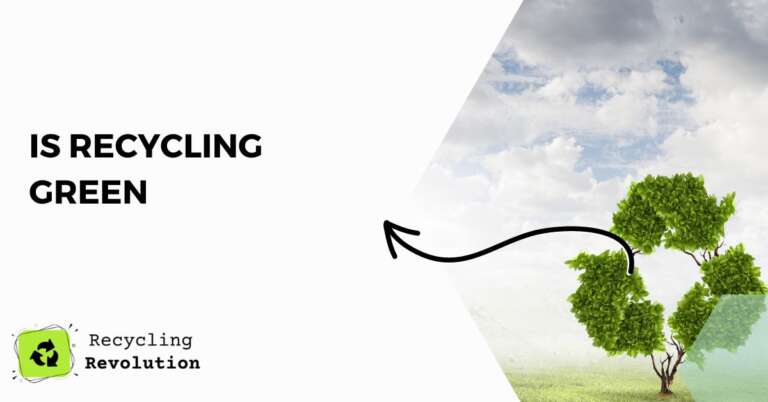Is Recycling a buzzword that’s been ingrained in our minds since childhood or is it actually a greener imprint on the world, we’ll go into it.
We’re taught the mantra of ‘Reduce, Reuse, Recycle,’ with recycling being perceived as the ultimate solution to the planet’s waste problem. But, how green is recycling?
This is where things get complicated. Yes, recycling has its advantages. It saves raw materials, reduces landfill waste, and can lead to energy conservation. However, recycling is not an entirely green process.
It involves energy consumption, sometimes in vast amounts, to sort, transport, and process recycled materials. Furthermore, depending on the methods used, it can produce pollution that affects both the environment and human health.
TL;DR: Recycling is a crucial part of green practices that has its roots in sustainability. However, it’s not entirely green due to the energy consumption, pollution, and complex logistics involved. To truly make recycling green, we need to reevaluate our consumption habits, promote circular economies, and advocate for advanced recycling technologies.
The Gray Areas of Recycling
Let’s dissect the recycling process to understand why it may not be as green as it appears.
- Energy Consumption: Recycling involves collecting, sorting, and processing materials, all of which consume energy. For example, recycling aluminum can save up to 95% of the energy needed to produce new aluminum from raw materials. Still, it’s not a zero-energy process.
- Pollution: The recycling process can emit pollutants. Recycling electronics, for example, can release toxic elements like lead and mercury into the environment if not handled correctly.
- Inefficiencies: Not all materials are recyclable, and not all recyclable materials end up being recycled. It’s estimated that only 9% of plastic ever produced has been recycled, with the rest ending up in landfills, oceans, or being incinerated.
Making Recycling Greener
I recommend that we adopt a holistic approach to improve the eco-friendliness of recycling. Here’s how we can make recycling greener:
- Promote Circular Economies: Instead of the traditional ‘take, make, dispose’ model, a circular economy aims to keep resources in use as long as possible. This can be achieved by designing products to last longer, making them easy to repair, and using materials that can be recycled effectively.
- Reduce Waste Generation: The best way to make recycling greener is by generating less waste in the first place. This calls for a shift in our consumption habits, favoring products with less packaging, opting for reusable items, and minimizing our overall consumption.
- Advocate for Advanced Recycling Technologies: Innovation in recycling technologies can make the process more efficient and less polluting.
Comparing Recycling with Alternatives
| Method | Pros | Cons |
|---|---|---|
| Recycling | Reduces demand for raw materials, Can save energy | Consumes energy, Can cause pollution, Not all materials are recyclable |
| Incineration | Reduces landfill waste, Can generate energy | Emits pollutants, Not sustainable |
| Composting | Natural process, Reduces landfill waste, Creates nutrient-rich soil | Not suitable for all types of waste |
| Landfills | Easy to implement | Harmful to the environment, Takes up space, Wastes resources |
The Complexities of Recycling
In our first exploration of the question, “Is Recycling Green?” we touched upon the idea that the recycling process is not as clear-cut as we may think. Despite its benefits, recycling also involves complex logistics and can potentially contribute to environmental degradation.
The Logistics of Recycling
Behind the scenes of the recycling process is a global network of collectors, processors, manufacturers, and consumers. The complexity of this system plays a significant role in the overall environmental impact of recycling.
- Collection and Sorting: After we deposit our recyclables into bins, these materials must be collected and sorted. The process often requires significant manual labor, in addition to automated sorting systems. Trucks must transport the materials to recycling facilities, which involves fuel consumption and CO2 emissions.
- Contamination: When non-recyclable materials end up in the recycling stream, they can contaminate the whole batch. This can happen when people ‘wishcycle,’ or throw items into the recycling bin hoping they can be recycled. For instance, greasy pizza boxes or plastic bags can render a batch of paper or cardboard unrecyclable.
- Global Market Forces: Recycled materials are commodities subject to global market forces. The viability of recycling can vary based on the supply and demand of these materials. In some cases, it’s more expensive to recycle materials than to produce them anew, especially when the prices for raw materials are low. This economic factor can affect the feasibility and environmental impact of recycling.
In Pursuit of a Greener Recycling
Despite these complexities and gray areas, recycling remains an essential component of our efforts to curb waste and conserve resources. To make recycling greener, we need to go beyond the process itself and address the broader systemic issues.
A Shift Towards Sustainable Consumption
As I previously mentioned, one of the most effective ways to make recycling greener is by reducing the waste we generate in the first place. This can be achieved through a shift towards more sustainable consumption.
- Mindful Consumption: Be aware of your consumption habits. Choose products with less packaging, opt for reusable items, and consider the lifecycle of the products you buy. Can they be repaired? Recycled? Composted?
- Zero Waste Lifestyle: A zero-waste lifestyle aims to eliminate waste altogether. This involves making mindful choices, such as buying in bulk, bringing your own containers, and avoiding single-use items. While it may not be feasible for everyone to achieve completely zero waste, every little step helps.
Investing in Recycling Innovations
Another key to greener recycling lies in technological innovation. By investing in advanced recycling technologies, we can address some of the inefficiencies and pollution issues associated with the current recycling process.
- Improved Sorting Technologies: Advanced sorting technologies can increase the efficiency of recycling, reducing contamination, and improving the quality of recycled materials.
- Chemical Recycling: This is a promising field that involves breaking down plastics to their molecular level, enabling the creation of high-quality plastic from recycled materials. This could potentially increase the recycling rate of plastics and reduce the demand for new plastic production.
- Eco-design: This approach involves designing products with their end-of-life in mind. By making products easier to recycle or compost, we can reduce waste and make recycling more efficient.
In the end, the question “Is Recycling Green?” doesn’t have a straightforward answer. Recycling is an integral part of sustainable waste management, but it’s not a silver bullet.
It’s part of a broader system that also includes reducing, reusing, composting, and other waste management strategies. To truly make recycling greener, we need to address these systemic issues and work towards a more sustainable society as a whole.
How You Can Become A Green Contributor To The World
the concept of “less is more” emphasizes the importance of consuming less, choosing products that have a long life, and opting for reusable items.
This approach is not only greener but also encourages mindful consumption. Here are some thorough tips on how individuals can contribute:
1. Opt for Reusable Items:
- Bags: Carry reusable cloth bags instead of using plastic bags.
- Water Bottles: Invest in a reusable water bottle to reduce single-use plastic consumption.
- Containers: Use reusable containers for food storage.
2. Choose Products with Long Life:
- Durability Matters: Purchase items that are built to last, from appliances to clothing.
- Warranties and Guarantees: Look for products with good warranties, indicating a manufacturer’s trust in the product’s longevity.
3. Buy Second-hand and Recycled Products:
- Thrift Shopping: Buying second-hand can save both money and resources.
- Recycled Content: Look for products made from recycled materials.
4. Mindful Energy Consumption:
- Energy-efficient Appliances: Choose appliances with higher energy efficiency ratings.
- LED Bulbs: Opt for LED lights which last longer and consume less energy.
5. Minimize Waste:
- Composting: Turn organic waste into compost for your garden.
- Recycling: Understand your local recycling guidelines and recycle appropriately.
6. Repair Instead of Replace:
- Fixing Items: Repairing items, whether it’s clothing or electronics, extends their life and reduces waste.
7. Digital Over Physical:
- E-books and Digital Subscriptions: Opt for digital versions of books, magazines, and bills.
8. Support Sustainable Brands:
- Ethical Choices: Purchase from companies that are committed to sustainability and ethical practices.
Conclusion
Recycling, once heralded as the ultimate solution to our planet’s waste problem, is far more complex and nuanced. While recycling does offer tangible benefits, such as saving raw materials, reducing landfill waste, and conserving energy, it is not without its shortcomings. Energy consumption, potential pollution, and intricate logistics make recycling less than completely green.
To augment the environmental effectiveness of recycling, we must embrace a comprehensive approach that involves not only recycling but also reducing and reusing. Mindful consumption, investing in reusable and long-lasting products, supporting sustainable brands, and advocating for advanced recycling technologies are keys to a more eco-conscious lifestyle.
In the end, recycling is not just a buzzword; it’s an essential but intricate part of a larger system aiming for sustainability. It requires our continuous commitment to understanding, improving, and evolving our habits and the way we view consumption and waste management. Only through collective efforts that go beyond recycling can we truly leave a greener imprint on the world.
FAQs
Can recycling become 100% green?
In its current form, probably not. However, with advancements in technology and a commitment to sustainable practices, it’s possible that recycling could become significantly greener in the future.
What is the most eco-friendly waste disposal method?
Composting is considered one of the most eco-friendly waste disposal methods for suitable waste types, as it’s a natural process that produces beneficial soil amendments.
Is reducing or reusing better than recycling?
Yes, reducing and reusing are generally considered more effective than recycling because they prevent waste from being generated in the first place.
What materials are most efficient to recycle?
Materials like aluminum, paper, and steel are among the most efficient to recycle, as they can be recycled without degrading their properties and save significant energy compared to producing new materials.

